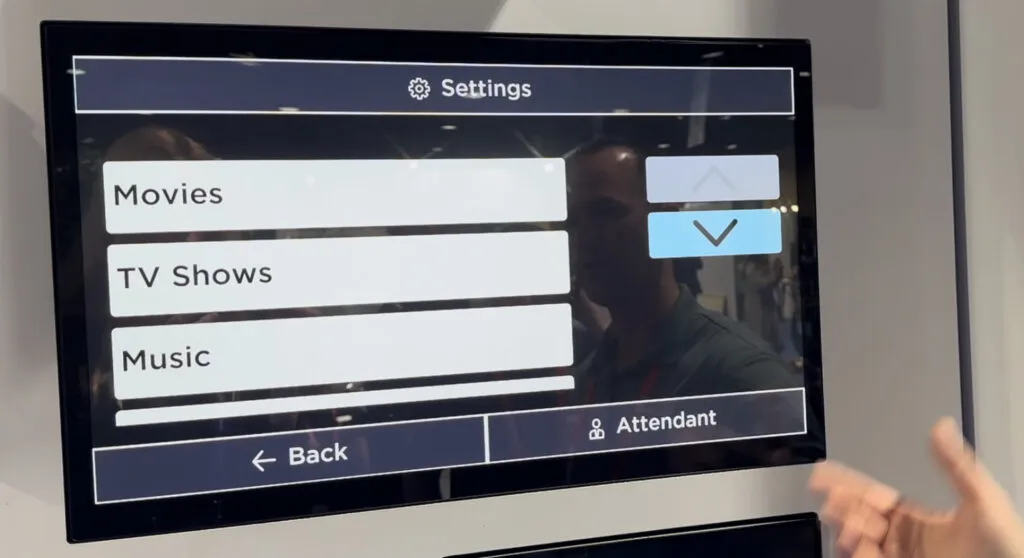Safran Passenger Innovations (SPI) is gearing up to launch its new accessible inflight entertainment solution this year, after soliciting feedback about the product from airlines and disability advocacy groups throughout 2023. Notably, SPI has taken an open source approach, with the aim of making the product available to other industry stakeholders that want to further develop it, or indeed adopt it.
Among its competencies, SPI builds the popular RAVE series of embedded IFE systems and associated RAVE OS software. Its new accessible IFE solution, called RAVE OS Accessible Mode, enables passengers with vision, auditory, and motor function difficulties to easily navigate in-seat IFE. The product is also designed to make IFE easier to use for neurodivergent passengers and others with cognitive disabilities.
RAVE OS Accessible Mode includes three key innovative features: what SPI calls a “configuration wizard” for passenger personalization; a dedicated simplified User Interface (UI) with a choice of graphical or text-based navigation including features to aid passengers with cognitive disabilities; and a screen reader that announces the feature selected in the UI through the passenger’s headset.
The Brea, California-headquartered company showcased RAVE OS Accessible Mode in 2023 at both the Aircraft Interiors Expo in Hamburg and the APEX/IFSA Global EXPO in Long Beach, California. “We’ve taken a different approach to the accessibility,” SPI vice president, global sales and marketing Jared Siqueland explained to RGN at the latter show, where he demoed an initial iteration of the solution for us.
Rather than simply taking an existing IFE UI and trying to adapt it to the needs of other passengers, he said, SPI built RAVE OS Accessible Mode “from scratch” to make IFE accessible to as many passengers as possible.
“[T]here’s different types of impairments and it’s not just a one-size-fits-all. I may have multiple impairments or different types of needs based on that impairment compared to others,” noted Siqueland. “And so we realized early on that we really need to create, not just a UI, but [understand] how a passenger interacts with the system from the start.”
RAVE OS Accessible Mode gives the passenger “the ability to configure at the beginning of the experience based on their specific needs, not just the category or classification of the need, but based on how they are going to be interacting,” he added.
It starts by asking each passenger a series of questions to personalize their mode.

Menus are presented as large buttons with either large high contrast text or icons, depending on passenger preference.

Critical functions for assistance, such as cabin attendant call and settings are present on every screen in the same prominent location allowing passengers to call for assistance or change options with no friction.

SPI believes that IFE must be more intuitive than consumer products so a passenger can quickly learn how to use the system during the first few minutes of arriving in their seat. This principle was embraced when imagining the RAVE OS Accessible Mode.
As a result of these design choices, noted Siqueland, the solution is “almost tailor-made” for each passenger from the get-go.
In addition to fielding feedback from airlines and other stakeholders at the airline passenger experience industry’s big exhibitions in 2023, Siqueland said SPI has been working closely with special interest groups, as well as one specific airline, which happens to have family members who would benefit from the product and has provided “great feedback”.
“It really is a community approach to really developing the product,” he said.
Initial implementations of RAVE OS Accessible Mode will start rolling out this year. But the product will continue to evolve.
Crucially, a foundation of SPI’s accessible IFE solution “is really going towards more of an open platform”. The firm anticipates that third parties will continue to develop in this space to the benefit of SPI, its airline customers, and indeed other stakeholders.
“We’re doing all the good work that we can possibly do, but we know there’s other experts in this field that are going to help us to refine that. And we really like the community development approach to the IFE system as a whole,” said Siqueland.
It’s important to note that some passengers who may not need accessible IFE today could find themselves needing it tomorrow, whether due to injury or simply the aging process.
“I started wearing glasses the last couple of years and I just broke them the other day. So, I’m sitting here on my phone trying to pinch and zoom and all this, and the same thing goes for the IFE system,” noted the SPI executive.
Related Articles:
- Op-Ed: Why “reg-neg” pact on accessible IFE should be preserved
- United impresses with accessible app for the blind
- Op-Ed: Standards should shape the future of accessible IFE
- Tying up loose ends: Neurodiversity and aviation safety
- How United’s accessible in-seat IFE lives up to expectations
- Accessible IFE comes in fits and starts, but regulatory push needed












